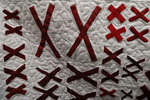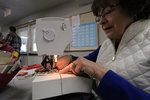


Nancy McGuire founded the North Star Quilters Guild in January of 2002, gathering quilters from south of Portland, Oregon up through Ridgefield. Since then, the Guild has participated in a variety of local projects aimed toward helping others. They have quilted blankets for beds at Open House Ministries, participated in Operation Warm Heart, researched and stitched together Fidget Quilts for the elderly with Alzheimer’s and Dementia, and labored to bring love in the form of a quilt to many of their loved ones and neighbors. The Guild is always looking for ways to help others and make a difference while doing what they are most passionate about.
One of the Guild’s recent focuses is “The 70273 Project.”
Between January 1940 and August 1941, roughly two years before the Holocaust, Nazi doctors decided the fate of 70,273 people — men, women, and children — based on the tellings of their medical records as a part of “Aktion T4.” If the doctors deemed someone who was physically or mentally disabled to be an economic burden on society, their medical record was marked with two red X’s, indicating they were to be executed.
The 70273 Project was born in February 2016. A North Carolina quilter named Jeanne Hewell-Chambers was stitching drawings by her 57-year-old intellectually disabled sister-in-law when an idea came to her. She decided to make a quilt with 70,273 white quilt blocks, each with two red X’s in it. Each block commemorates one of the people killed.
North Star Quilters Guild’s interest began when some of its members attended the 44th Annual Quilt Show in Portland in May 2018, where they were able to view a portion of The 70273 Project’s traveling quilt exhibit, and meet Hewell-Chambers.
After being introduced to The 70273 Project, members of the Guild were in awe. They felt a strong pull to participate in something so meaningful. One member, Peggy Muelly, felt a personal connection.
“My granddaughter. She wouldn’t make it through,” Muelly shared with The Reflector. “People forget,” she later added.
The guild decided to band together with Hewell-Chambers. After the quilt show, some research and correspondence with Hewell-Chambers, they began stitching together their quilt blocks, contributing to the international project by making a quilt of their own, clad in white blocks, each bearing two red X’s.
The Guild’s quilt, along with thousands of others, now commemorates the 70,273 who died as Hewell-Chambers travels the world with the quilts, displaying them in schools and other community settings.
Observing the stark white background scattered with red X’s is a humbling reminder; many of the quilters struggle to hold back tears when they discuss the quilt and its meaning.
“Every time the quilt comes out it is an emotional time,” McGuire said.
According to their blog, in just three years The 70273 Project has exceeded its goal of 70,273, but the founder has no plans for stopping — yet.
“Though we don’t have a firm count, we know that there were far more than 70,273 disabled people murdered during World War II,” Hewell-Chambers writes on her blog. “Some estimates are as high as 300,000. The reality is that I cannot store an infinite number of quilts, but for now, it’s as simple as this: we keep stitching; we keep sharing; we keep honoring.”
{{tncms-inline content="<p class="p1"><span class="s1">To learn more about The 70273 Project and follow the quilt&rsquo;s journey visit the70273Project.org.<span class="Apple-converted-space">&nbsp;</span></span></p>" id="f5f9d4cf-559a-4029-ac45-8642f34e447e" style-type="info" title="Learn more" type="relcontent"}}